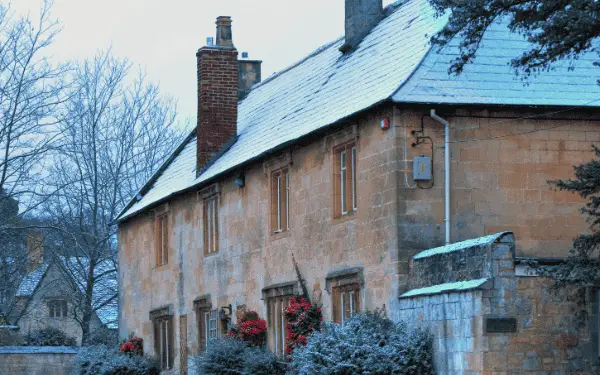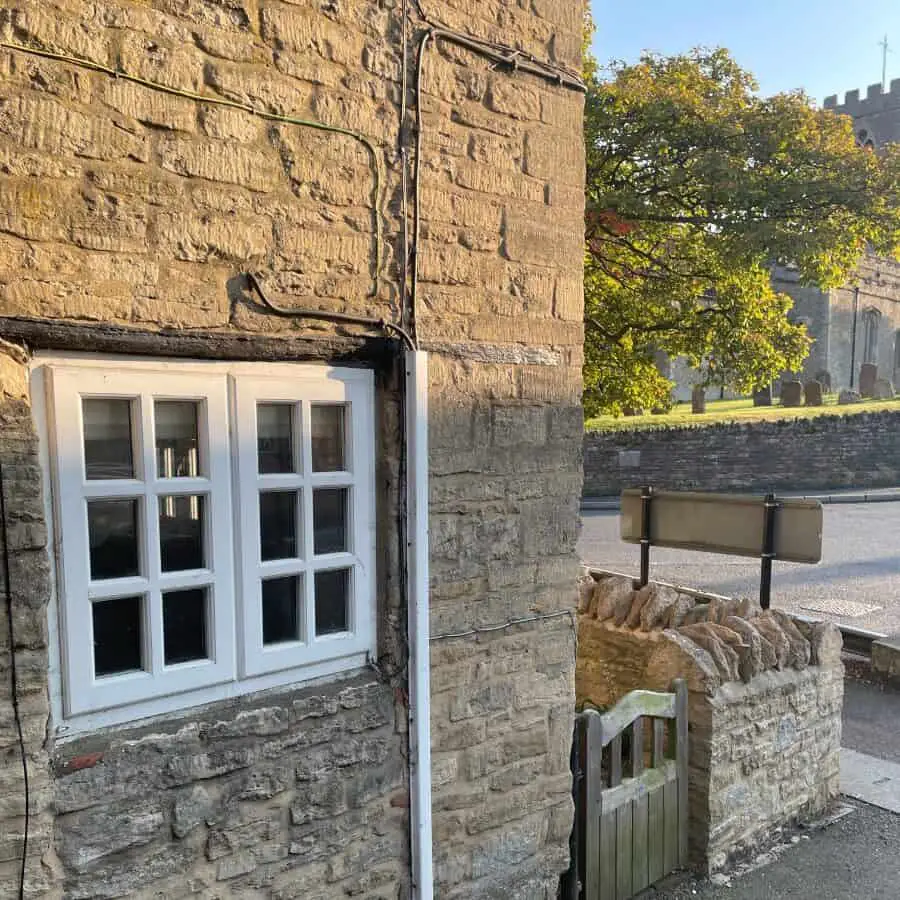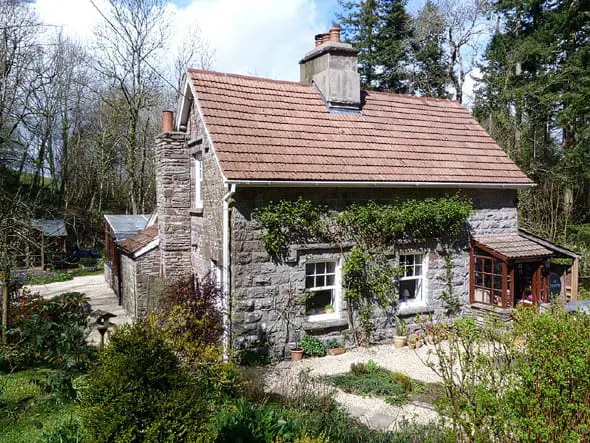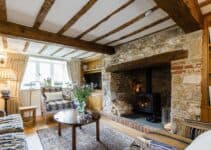Living in a quaint stone cottage is all well and good until winter rolls around and you realise they can be pretty cold. This is primarily due to their age and building techniques, but it’s possible to do something about it.
In this article, we’ll look at how to insulate a stone cottage. Before we get onto that, let’s go over why stone cottages are actually cold.
Are Stone Cottages Cold?
Stone cottages can get pretty cold in autumn and winter. However, they can also remain fairly cool in warmer months, which is an advantage.
That said, insulating a stone cottage will keep it cool in the summer but will help it stay warm in the winter.

Why are Stone Houses Cold?
The more important question to ask is why are stone houses cold? There are a couple of important points to consider here, which will also impact how you insulate the building.
Construction Technique
First, we must think about construction technique. Stone cottages, generally, only have a single wall.
It can be fairly thick and have rendering on both sides, but it’s still only one wall between the outside and inside.
Another thing we must consider – although it’s a less important factor – is the potential age of a stone cottage. Older buildings are more likely to have gaps in their rendering or small holes due to poorer construction techniques.
Any hole is a bad thing when it comes to retaining heat, and a lot of porous rendering between stones won’t help either.
This means that heat can transfer quite easily, resulting in the stone house being cold in the winter.
Insulation vs. Thermal Mass
Stone is a poor insulator because it doesn’t prevent heat from passing through it. Typically, a good insulator will have a way of trapping heat, such as air pockets or its atomic structure doesn’t allow for the transfer of energy.
However, stone has high thermal mass, which is a different concept from insulation. In short, thermal mass is a material’s ability to absorb, store and radiate heat.
This is different from insulation because the latter involves trapping and/or preventing the transfer of heat energy.

Thermal mass is essentially all about the transfer of heat, focusing on how much a material can absorb and how quickly it then radiates the stored heat energy. It works like this:
1. The stone wall has the sun shine on it. This causes it to absorb heat energy.
2. Stone is dense, meaning the heat energy transfers through the material at a very slow rate.
3. By evening, it’s likely made its way into the building, and the process will start again tomorrow.
But why does this difference matter?
Essentially, thermal transfer works both ways, so in the winter, you’ll be constantly losing heat from inside your home due to the colder outside temperatures. Not only is this inefficient for your heating system, it also means your house will be cold.

Stone isn’t a good insulator on its own. Its thermal transfer properties can be helpful in the summer or between rooms (i.e., when using a log burner), but it’s not super useful in the winter.
Stone has very little air trapped inside it (because it’s dense) and so it has no way of preventing the heat energy from escaping outside.
Are Stone Houses Colder than Brick?
Stone houses are colder than brick mainly due to the way they’re built. Stone and brick have very similar thermal mass values, although brick is a marginally better insulator because it’s less dense than stone.
However, the more important difference is the use of cavity walls. As you may already know, a cavity wall is an outer wall of brick and an inner wall of something like breeze blocks.
Between them is an air gap – the cavity.
Cavity walls were introduced in the UK in the 19th century and had become the norm by the 1920s. Their original purpose was to act as a rain barrier, as bricks are porous and easily let rain in.
Without the gap, rain would cause humidity within the building, which could lead to problems with damp.
But cavity walls are also useful for insulation. Air is a very poor conductor of heat (in turn making it a good insulator).
The cavity essentially makes heat transfer much slower, rather than preventing it from happening. However, air can transmit heat through convection, so it helps to fill the cavity with an insulation material.
The best examples are things like fibreglass, rockwool or blown insulation.
I like this rockwool best:
It’s seen as such a successful way to improve insulation that the UK government offers grants to get it done for free.
But the point is that stone cottages are typically single skin (one wall), meaning there’s no air cavity or any other gap between the inside and outside. So, while the materials have similar thermal mass values, a single wall of anything will pretty much always be colder than a twin wall of materials.
How to Keep a Stone Cottage Warm
Now that we understand why stone isn’t a good insulator, let’s go over some options for improving it.
Before thinking about insulation options, it’s vital that you consider your home’s breathability. It might sound like something made up, but materials such as stone are porous.
This means water vapour (created by cooking, breathing, etc.) can escape through the walls.

Some insulation techniques will make stone walls impermeable, resulting in a build-up of moisture inside. In turn, this creates damp and mould, which you obviously don’t want.
The easiest way to control damp is by maintaining airflow. Combine this with proper internal heating, and you shouldn’t have much problem with moisture.
1. Curtains
Curtains might be an obvious place to start, but they can be incredibly useful for keeping your stone cottage warm. You’ve probably already got curtains over your windows, which is good because glass is an even worse insulator than stone.
But consider hanging curtains in front of doors and at the bottom of the stairwell. The aim is to reduce drafts and add extra insulation to thinner areas in the home.
Of course, if you want a quick option for insulating walls, you can hang curtains over them, too.
I love insulation curtains like these which are designed to exclude drafts and made from thermal materials:
Use the thickest curtains you can find. At the very least, they should be lined. Velvet curtains are one of the best types for insulation, simply because they’re so thick.
Open them during the day to let heat in from sunlight and then close them as soon as the sun goes down.
2. Framing
Framing walls involves putting up a timber structure inside rooms, behind which you can hide insulation materials. You’d then cover the frame with plasterboard or a similar material.
The benefit of using framing is that there’s more space for insulation. Some of the best insulation materials for this option are:
· Fibreglass boards
· Rockwool
· Blown insulation
· Recycled fabric (either boards or loose)
· Hemp board
As you can probably guess, this does mean losing quite a bit of space in your rooms. However, it’s a good option for retaining breathability, as none of these materials is fully impermeable.
And, they’re all dedicated insulation materials, so they’ll offer the best results.
Another thing to bear in mind is that you might not be able to make such drastic structural changes. It’s not the most invasive job in the world, but you’ll struggle to get approval if you live in a listed building.
So, check with an architect and your local planning office before you give this method a go.
3. Loft Insulation
We can’t overlook the roof as a source of heat loss, particularly as it can account for up to 25% of it. Plus, comparatively speaking, lofts are very easy to insulate.
I love Earthwool loft insulation:
The materials you’d use aren’t any different to those suggested above. However, installation should be much simpler because you’re working with a large open space.
You can also insulate thatched roofs, but it’ll be worth calling in an expert for advice. There shouldn’t be any issues with listed buildings, as loft insulation is fairly non-invasive and the government is a big fan of it.
4. Improving Windows
Ideally, your home should have double glazing. But if it’s an old and/or listed building, this might not be the case.
Single-glazed windows are awful for heat loss and, although they’re not the main topic of this article, they’re worth mentioning.
You’re bound to lose more heat through even the smallest single-glazed windows than you will through a stone wall. As such, it’s worth doing something about it.
The most obvious solution is to replace them with double-glazed windows, but this might not be possible if your home is listed. Instead, try insulating film. It essentially replicates the idea of double-glazing but it’s temporary.
While you’re sorting out the windows, consider installing some weather stripping. It’s thin foam tape that seals gaps around windows, which can be caused by buildings shifting. You can use it around door frames, too.
5. Insulating Directly onto Stone Walls
If framing isn’t an option, you can install insulation directly onto stone walls. You’ll still lose space in the room but it won’t be as much. However, the flipside of this is that the results won’t be as good.
The most obvious product to use is calcium silicate board. It’s a popular type of insulation board that comes in a range of thicknesses, giving you flexibility over how much space you lose.
You’ll want to combine it with a vapour-permeable adhesive so the walls can still breathe.
The board itself is permeable, but most adhesives aren’t. Also, you can plaster over the board, giving you the same wall finish you’d find elsewhere.
Another option that’s proving to be increasingly popular in old stone cottages is insulating lime plaster:
Listed buildings might even be restricted in what type of plaster they can use due to breathability of walls, so this should meet those needs.
It’s basically normal lime plaster that contains hollow beads, usually made from glass. These create air pockets, slowing down heat loss through the wall. For best results, you’ll need between 50 and 80mm of plaster applied in several layers.
6. Put Down Rugs
In particularly old buildings, there’s every chance you don’t have a foundation under the floors. It’s not uncommon for them to be laid on packed earth, which can result in a lot of heat loss.
Short of digging up the floor, the next best option is to put down rugs. While this won’t have the same kind of results as wall insulation, it’ll at least make floors feel warmer. A bare hard floor can feel like it’s sucking the heat out of the room, so laying down rugs will address this problem.
7. Aerogel Blanket
Aerogel is touted as the world’s lightest solid materials – it consists of up to 99.98% air. As we’ve established, air is a useful insulator because it doesn’t conduct heat well.
In fact, most insulation materials work well because they create air pockets. And what could be better than a product that’s nearly 100% air?
To use aerogel, you’ll first need to instal something like steel mesh. This will basically act as the frame onto which you fit the aerogel, as it’ll need a suitable surface to adhere to. You can then apply plaster as normal over the top.
The main benefit compared to other options is that it’ll only add an extra 25mm per wall, making it much thinner than the other options. Plus, you can easily use it on curved surfaces, which are pretty much all walls in old buildings!
Final Thoughts on Insulating a Stone Cottage
Insulating a stone cottage can take a bit of work, but it’s definitely possible. Similarly, it’ll seem like an expensive investment depending on what method you use. However, after a few years, you should notice something of a return on your investment.
Of course, if you’re unsure of how to proceed, make sure you speak to an insulation expert for specific advice regarding your stone cottage.










